Angela Slatter's Blog, page 28
July 3, 2018
Suspended in Dusk II: Dan Rabarts
 Today’s SiDII author is Dan Rabarts, talking about his story “Riptide”.
Today’s SiDII author is Dan Rabarts, talking about his story “Riptide”.
1. What was the inspiration for your SiD2 story?
Several years ago I was working on story fragments for an anthology called Regeneration, and one of those story threads started with the idea of the tide, and how it washes up the beach to sweep away the traces of the past few hours to leave it clean, fresh. This story drew me into a place I struggled to go, especially since the beach that forms the background of Riptide is a place I know very well, a stretch of sea where I spent many hours growing up, a stretch of sea that once tried to hold onto me forever. On the one hand, this story is an exploration of what might’ve been, had things gone differently that particular day, and how so many of the monsters we live with we never see and so struggle to confront. I ended up placing a (very) different story in Regeneration, but I’ll always credit the editors for planting the seed of this story, which is particularly personal to me.
2. Who are your top five horror-writing inspirations?
Only five? Let’s mention Mr King, since reading IT when I was 14 I simply had to find more stories that left me haunted. Kiwi fantasy/sci-fi author Hugh Cook, now sadly deceased, is right up there too. His writing is slivered through with moments of sudden, brutal darkness, and as another author I was reading in my mid-teens, his impact has had an influence on my writing from the time I first tried my hand at wordsmithing. (That’s a Hugh Cook reference, BTW. See what I mean?). A couple of indie authors are next on the list, starting with Jack Kincaid. Kincaid’s novel Hoad’s Grim, a notoriously underappreciated book which I first experienced as an audiobook drama and which remains my preferred entertainment for long drives up the country on my own in the dark, brought me squarely back into the horror zone after a few years of traipsing around in fantasy worlds.This also drew me into the realm of podcast fiction, where I discovered Phil Rossi and his cosmic horror, including Crescent, Eden and Harvey. And no such list of this nature could be complete without mentioning the single biggest inspiration in my efforts to create dark fiction that resonates, burns, and haunts, and that of course is Lee Murray, my writing partner and one of my favourite authors hands-down.
3. You get to choose one book for a desert island exile (yes, you did something terrible): what is it?
The Complete Guide to Self-Sufficiency? Bear Grylls’ Survival Almanac? Weave Your Empire from a Coconut Palm?
4. What’s your favourite trope in horror? 
Probably the well-worn path that the monster is not really the monster we think it is; that the real monsters are inside us. People are far more monstrous than any vampire or zombie can ever be, thanks to man’s inhumanity to man and all that, which is possibly why I’m such a fan of dystopia and apocalyptic fiction where the horror stems from what we’re capable to doing to our world and to each other. Possibly because those are far more real terrors than the made-up ones, and also because if fiction serves a purpose it may be as a warning to the rest of the world, and although we’ll never know if those warnings just might change the future, we scream them to the darkness regardless, hoping someone can hear us.
5. What’s next for you?
I have two novels due for release later this year. Teeth of the Wolf, the sequel to Hounds of the Underworld with Lee Murray is due out from Raw Dog Screaming Press in October, and we’re just starting work on Book 3. Brothers of the Knife, the first book in the Children of Bane dark fantasy series from Omnium Gatherum is due out later this year, with the second book, Sons of the Curse, slated for early next year. The third book in that series, Sisters of Spindrift, is my current work in progress and the reason I get up at some insane cold hour of the morning to tap words onto a screen to the smell of hot coffee. I’ve also got short fiction due out this year in Cthulhu: Land of the Long White Cloud, and Pantheon Magazine. So basically, what’s next for me is a lot of daily wordcounts and quite a bit of proofing and editing. And early morning coffee.
Bio:
Dan Rabarts is a New Zealand author, editor and podcast narrator, winner of four Sir Julius Vogel Awards and two Australian Shadows Awards, occasional sailor of sailing things, part-time metalhead and father of two wee miracles in a house on a hill under the southern sun. His science fiction, dark fantasy and horror short stories have been published in venues such as Beneath Ceaseless Skies and The Mammoth Book of Dieselpunk. Together with Lee Murray, he co-edited the award-winning anthologies Baby Teeth – Bite-sized Tales of Terror and At The Edge, and co-writes the Path of Ra series from Raw Dog Screaming Press, starting with Hounds of the Underworld and continuing in Teeth of the Wolf. His first solo novel, Brothers of the Knife, kicks off the grimdark-yet-madcap Children of Bane fantasy series (Omnium Gatherum) in late 2018. Find out more at dan.rabarts.com.
June 26, 2018
Suspended in Dusk II: Karen Runge
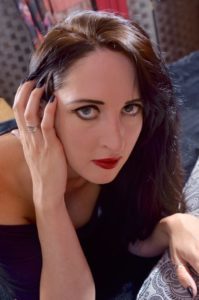 Karen Runge is an author and visual artist based in Johannesburg, South Africa. Her works have appeared in various anthologies and other publications around the world. Her first solo short story collection, ‘Seven Sins’ was published by Concord Free Press in 2016, and her first novel ‘Seeing Double’ made its debut in 2017, from Grey Matter Press. Never shy of darker themes in horror fiction, she has been dubbed ‘The Queen of Extreme’ and ‘Princess of Pain’ by various bloggers and book reviewers. The late Jack Ketchum once said in response to one of her stories: ‘Karen, you scare me.’
Karen Runge is an author and visual artist based in Johannesburg, South Africa. Her works have appeared in various anthologies and other publications around the world. Her first solo short story collection, ‘Seven Sins’ was published by Concord Free Press in 2016, and her first novel ‘Seeing Double’ made its debut in 2017, from Grey Matter Press. Never shy of darker themes in horror fiction, she has been dubbed ‘The Queen of Extreme’ and ‘Princess of Pain’ by various bloggers and book reviewers. The late Jack Ketchum once said in response to one of her stories: ‘Karen, you scare me.’
1. What was the inspiration for your SiD2 story, ‘Angeline’?
The song ‘Angelene’ by PJ Harvey. I even used the name, just with slightly altered spelling. I love PJ Harvey’s music. Apart from her gorgeous sound, her lyrics are so poetic and powerful, often with something dark or sinister seething just out of sight. The lyrics to that song in particular had me gripped for a good while before I realised this fascination was my own subconscious telling me to write something around them. I bade the call, and so ‘Angeline’ was born.
2. Who are your top five horror-writing inspirations?
I always loved horror and always wanted to be a writer. When I hit my teens I was ripping through books like a rabid wolf, and realised that there is a lot of horror in what people describe as more ‘literary’ works. Those are the ones that really set me on the path to forming my own style. John Fowles’ ‘The Collector’, Margaret Atwood’s ‘A Handmaid’s Tale’, Joyce Carol Oates’ ‘Man Crazy’ each in their own way had a huge impact on me. Then there’s the obligatory Stephen King (in my case it was ‘Carrie’—just wow), and Clive Barker’s ‘Books of Blood’. I think all this rounded me out as a writer who goes for detailed prose and deep character development, with a strong draw for digging into the disturbing and the unspeakable. This would also explain why my own stories seldom have supernatural elements—I’m all about the psych.
3. You get to choose one book for a desert island exile (yes, you did something terrible): what is it?
So I’ll surprise the hell out of everyone here and say my pick is ‘The Coral Island’ by R.M. Ballantyne. First, it’s a great read with likable characters and a fantastically fun ‘journey’ type of plot. Second, the horror elements in it (which blindside the reader about a third of the way through) are some of the most extreme I’ve ever read. To give you an idea, to this day I don’t eat pork—I’m actually phobic about the very idea of eating pork—and 50% of the blame for that lies at this book’s feet. (The other 50% belongs to ‘Nightmare on Elm Street 5: The Dream Child’. I read this book and watched this movie at around the same time. That ‘time’ being when I was still way too young for either of them. And yes, it’s quite evident that I’m still scarred!) The other benefit to taking this book with me is that it’s full of groovy little tips on how to survive an island marooning type situation. I’d say that makes it the best pick all round.
4. What’s your favourite trope in horror?
It’s probably easier for me to talk about tropes I don’t like than tropes that I do. I’m all the way zombie’d out, for example. I really wish we’d let those undead dudes rest for a little while, please. They’ve damn well earned it. I’m a big believer that any trope (so long as it isn’t tired as all hell, as in the case of zombies) can work if it’s handled from a fresh perspective. Stephen Graham Jones’ ‘The Last Final Girl’ was a hilarious and very well written dig at the whole Final Girl thing, for example. It was so all the way in the reader’s face, and owning it, that it couldn’t be anything but a fresh take. There isn’t much out there that can’t be done well, because as is true in most things, it’s not WHAT you’re doing so much as it is HOW you’re doing it.
5. What’s next for you? 
I’m currently involved in a very big and very exciting project which I very unfortunately cannot talk about just yet! It’ll be a great day when I finally get to make that announcement. In the meantime I’m busting my behind on a few new shorts, and I also have a novel currently sulking in the corner. Each of these are at varying stages of development, but I’m currently in a great space as an artist and am really enjoying everything I’m doing.
Suspended in Dusk II is out from Grey Matter Press and edited by Simon Dewar.
Kickstarter: Women Up to No Good
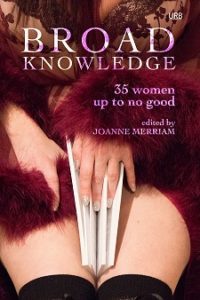 Upper Rubber Boot are kickstarting two awesome anthologies: Broad Knowledge and Sharp & Sugar Tooth!
Upper Rubber Boot are kickstarting two awesome anthologies: Broad Knowledge and Sharp & Sugar Tooth!
If you’ve got some spare shekels, throw them this way!
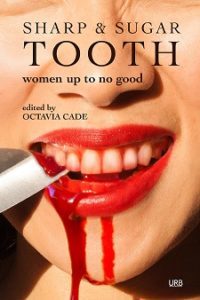
June 13, 2018
Thanks, Hannah!
 Gorgeous review of The Girl with No Hands and Other Tales by Hannah right here.
Gorgeous review of The Girl with No Hands and Other Tales by Hannah right here.
Thanks, Erica O. for recommending me!
I love it when people discover books like this; first published in 2011, I love that she’s still getting new readers!
Gaslight Gothic!
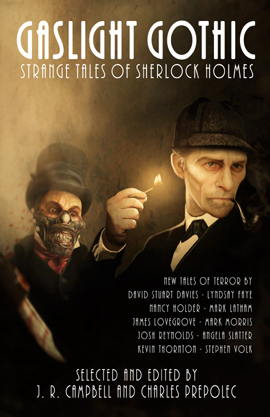 I’m so very excited to have a story in this wonderful anthology from EDGE, edited by JR Campbell and Charles Prepolec! Gaslight Gothic has a Kit Caswell (Ripper) story in it, called “A Matter of Light” – and she gets to take on Sherlock Holmes himself! This was a huge challenge, but I’m pretty happy with the result.
I’m so very excited to have a story in this wonderful anthology from EDGE, edited by JR Campbell and Charles Prepolec! Gaslight Gothic has a Kit Caswell (Ripper) story in it, called “A Matter of Light” – and she gets to take on Sherlock Holmes himself! This was a huge challenge, but I’m pretty happy with the result.
The fourth anthology in the Gaslight series explores the darkest side of the world’s most popular detective, Sherlock Holmes. Gaslight Gothic features dark fiction by esteemed authors:
David Stuart Davies
Lyndsay Faye
Nancy Holder
Mark A. Latham
James Lovegrove
Mark Morris
Josh Reynolds
Angela Slatter
Kevin P. Thornton
Stephen Volk
Gaslight Gothic: Strange Tales of Sherlock Holmes will be available for preorder on Kindle on June 23, 2018 Watch for details at our EDGE Science Fiction and Fantasy Publishing website: http://www.edgewebsite.com/
June 12, 2018
The Lovecraft Squad: Dreaming
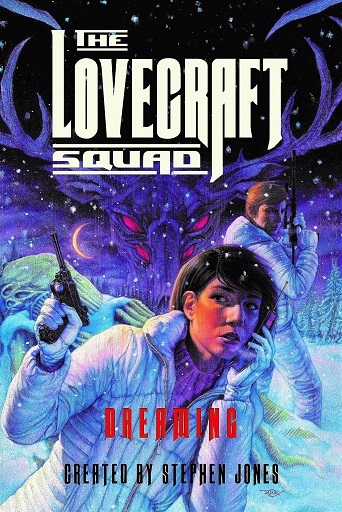 Cover reveal for the next instalment in the Stephen Jones curated mosaic novel, The Lovecraft Squad: Dreaming.
Cover reveal for the next instalment in the Stephen Jones curated mosaic novel, The Lovecraft Squad: Dreaming.
I’ve got a story in here, along with such luminaries as Kim Newman, Pete Adkins, Brian Hodge, Lisa Morton, Lynda E. Rucker, Michael Marshall Smith …
From Pegasus Books, and available for pre-order!
June 9, 2018
Corpselight won an Australian Shadows Award!
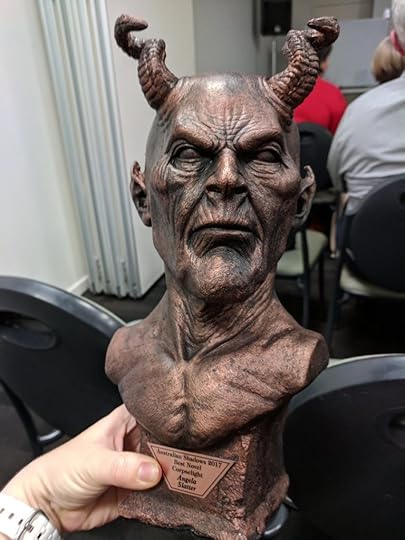 What a delight! The big demon head can sit on the shelf next to the HP Lovecraft head and they can glare at each other for eternity!
What a delight! The big demon head can sit on the shelf next to the HP Lovecraft head and they can glare at each other for eternity!
Thanks to the judges and the organisers, thanks to the wonderful Kat Clay for accepting on my behalf and Jenny Breukelaar for transporting the heavy thing to Sydney for me to collect, and thank you so much to my fellow shortlistees: your works are astonishing and I am both humbled and honoured to be amongst you.
June 2, 2018
And then this happened …
 … some days you get an email like this one and it makes you so damned happy! Thanks, Kaja Holzheimer, I’m so proud of you!!
… some days you get an email like this one and it makes you so damned happy! Thanks, Kaja Holzheimer, I’m so proud of you!!
Hi Angela, This might seem a little out of the blue… I’m writing to THANK you for the time and effort and wisdom you put into the classes I took with you through QWC back in 2012. Why do this now? Because tomorrow I check in to the Odyssey 2018 Writing Workshop, here in Manchester, New Hampshire for 6 weeks of writing madness. And I recognise how much your support, your early and emphatic encouragement, and your slightly terrifying critiques helped to get me here. I still have so much to learn–about writing, about craft, about “persistence-despite”–and I think I’m finally ready to learn it. (Some of us are slower than others…) So. Thank-you for pointing me in the right direction and giving me a little push. I am so looking forward to this opportunity! Catch you later, Kaja
June 1, 2018
Every time!
Check out the artwork on the deluxe edition of The Tommyknockers! Every time I see something new I’m just astounded. 
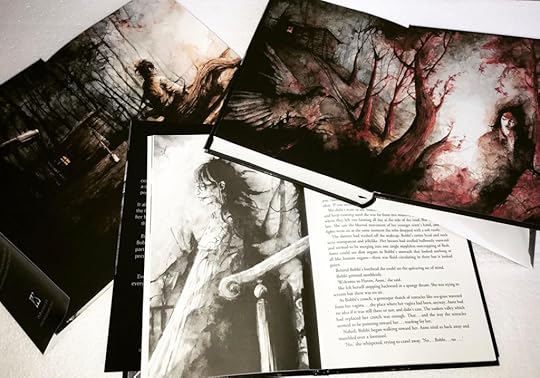
May 31, 2018
The Teardrop Method: Simon Avery
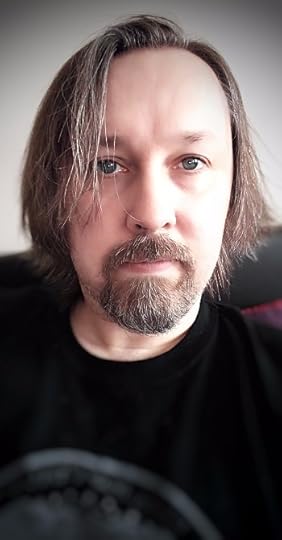
Today, Mr Simon Avery takes over the blog to talk about writing in general and his TTA novella, The Teardrop Method.
1. How did you start out?
I worked at Andromeda bookshop in Birmingham from 1988 for ten years. For the genre fan of a certain age, Andromeda – then the world’s oldest and longest running SF/Fantasy bookstore – was the place of pilgrimage. People from all over the world visited our humble little shop in Birmingham. It was where I decided that writing was something I wanted – and needed – to do. I met hundreds of authors during my years there – a veritable who’s who of genre writing: Clive Barker, Iain Banks, Peter Straub, Terry Pratchett, Neil Gaiman, Anne Rice, Dan Simmons… It was hugely inspiring to be able to spend time with these people and discuss their craft. I have some fond memories of those years.
In the early nineties I also discovered the slipstream movement that featured in Christopher Kenworthy’s Barrington Books anthologies and in Andy Cox’s The Third Alternative. Joel Lane in particular was a massive influence on my first few years’ work. Joel was a mentor to me, as well as a great friend. We were introduced to each other in the early 90’s at Andromeda Bookshop. I have fond memories of hours spent in pubs, curry houses and parties, discussing anything and everything with him.
He read my first story, Suzanne, and gave me some pretty detailed analysis and feedback. It was published by Chris Kenworthy in the Watch Fire anthology in 1995. He also suggested I send something to Andy Cox, who is the other person instrumental in my writing career. That was Blue Nothings, also published in 1995. Andy has always been a great supporter of my work, and has continued to publish it for over twenty years now, in The Third Alternative, in Black Static and most recently in TTA Press’s novella range.
2. What was the inspiration behind The Teardrop Method?
A couple of things. After meeting my girlfriend, Amanda, we started to travel across Europe for our annual holidays. Paris, Rome, Venice, Bruges, Lake Garda, Salzburg… Somewhere along the way, I decided I wanted to write something that was drenched in the atmosphere of a fading European city in the snow, and Budapest became the destination that fitted the story I wanted to tell.
The other thing grew out of a fascination with reclusive artists, particularly musicians. I knew very early on that I wanted to base the character of Krizstina on the Swedish singer/songwriter Stina Nordenstam. I’ve been a fan of her work since she released her debut album back in 1991. She hasn’t released anything since 2004. Her website has gone, the Facebook group only lights up with old videos, and the message boards have nothing to report. No one it seems knows what she’s been doing these past 14 years. In this day and age of social media, I find it fascinating that someone can abandon their career and fade out of view so completely.
The Teardrop Method was a way to combine the atmosphere of a wintry Budapest with a strong female character who takes herself out of the view of the public for a very specific reason. From that I found myself wanting to write about creativity and loss and how you recover from tragedy.
3. Are you a big plotter and planner or a pantser?
I can’t even begin until I have notes spilling off the table and onto the floor. Sequences half-written out, jumping off points, a title before I begin anything; safety nets galore. But somehow I still allow myself some leeway so I can allow the characters to breathe and maybe go their own way. Just not too far…
4. Who are your top five literary inspirations? 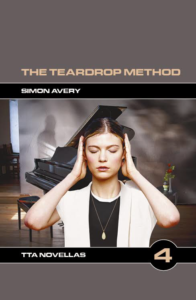
John Harrison, James Salter, Joel Lane, Jonathan Carroll, Robert Aickman.
5. Which do you prefer: writing the first draft or doing the editing afterwards to make it shiny?
I like certain aspects of both processes. Although I find the notion of actually sitting down and trying to create something good fraught with all sorts of anxieties, the days when you feel like you’re flying and the characters are telling you what to do make that process completely worth it. Editing is much simpler. I can put on records and play with the dog while I’m doing it. My girlfriend also prefers it to those first draft days where I’m banging my head against the table, wondering what the point of it all is.
6. Can you remember the first story you read that made you want to be a writer?
Early on, in my teens, it was probably something by Jonathan Carroll or Clive Barker. But when I decided that this was something I wanted to do with real conviction, it was ‘And Some Are Missing’, by Joel Lane.
7. What attracts you to speculative fiction?
I enjoy the moment when strangeness creeps into a scene of relative normality, and illuminates some aspect of character or changes the way we see things. I think I’ve been paring away that strangeness over the years, seeing how far I can get with a story before it arrives and turns everything on its head.
8. You get to take five books with you to a desert island – which ones do you choose?
Land of Laughs by Jonathan Carroll, The Course of the Heart by M. John Harrison, Watership Down by Richard Adams, The Magus by John Fowles, The Amazing Adventures of Kavalier and Clay by Michael Chabon.
9. Who’s your favourite villain in speculative fiction, novel or film?
Norman Bates, Hannibal Lecter, the Joker or the Wicked Witch of the West. I cannot narrow that list down!
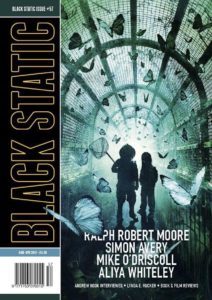 10. What’s next for Simon Avery?
10. What’s next for Simon Avery?
This month sees a new novelette appearing in Occult Detective Quarterly 4 featuring a character that started out in Sunflower Junction, a story that appeared in Black Static 57. I’m aiming to write a series of loosely connected stories featuring him, with a view to collecting them all together in one volume somewhere down the line. The stories reside in a very English area of folk horror and Hauntology. As I get close to the end, I intend to arc the stories into something more connected so that the collection has a very definite beginning, middle and end.
I’ve also just completed a new novella, called PoppyHarp. I’m delighted with how it’s turned out. It’s inspired by the nostalgia for children’s programming from the seventies, the animation of Jan Svankmejer, Alice in Wonderland, London and the BBC, and Underground bunkers from the Cold War. It felt like I was going somewhere new with it, which is exactly the feeling you want from writing. Once it’s edited, I’ll be sending it out into the world.
Simon Avery’s fiction has been published in a variety of magazines and anthologies, including Black Static, Crimewave, The Third Alternative, The Best British Mysteries IV, Beneath the Ground and Birmingham Noir. This month he features in the Joel Lane tribute book, Something Remains, and a story, A Very Lonely Revolution will be published in the next issue of Black Static.
A novella, The Teardrop Method is forthcoming in September from TTA Press.



